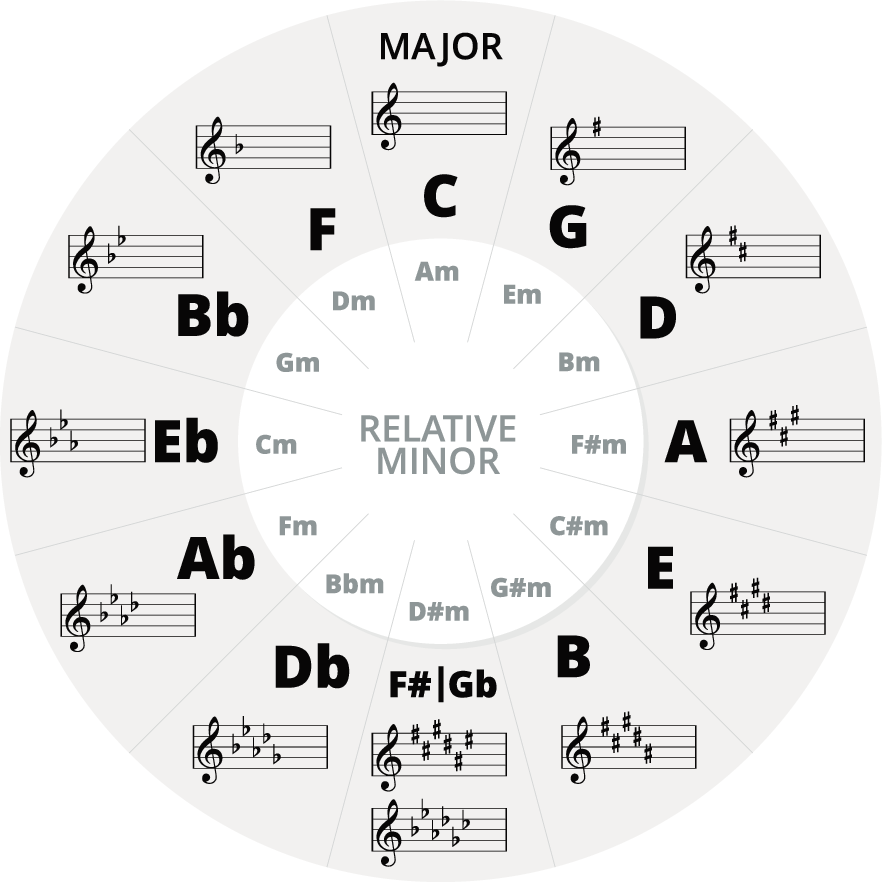
Father Charles Goes Down And Ends Battle
This is a helpful word aid for remembering the circle from the F position. If you then consider that Fb = E and Cb = B, the word aid (in flattened form) re-occurs from E (Fb) B (Cb) Gb Db Ab Eb Bb, completing the circle.
As you move clockwise around the circle, you are moving in ascending 5ths – G is up a 5th from C, D is up a 5th from G, etc. As you move counter-clockwise, you are moving in descending 5ths – F is down a 5th from C, Bb is down a 5th from F, etc.
The Sharp Keys – #
The FCGDAEB word-aid is also the order that the sharps are added to keys.
C is the neutral key, meaning that it has no sharps or flats. As you move clockwise, you add one sharp for every key. G (at 1 o’clock) has 1 sharp. D (at 2 o’clock) has 2 sharps. A (at 3 o’clock) has 3 sharps, and it goes like this all the way to F# (6 o’clock) which has 6 sharps. Here is how the notes organise themselves moving through the sharp keys.
| G | ||||||
| F# | C | G | D | A | E | B |
| D | ||||||
| F# | C# | G | D | A | E | B |
| A | ||||||
| F# | C# | G# | D | A | E | B |
| E | ||||||
| F# | C# | G# | D# | A | E | B |
| B | ||||||
| F# | C# | G# | D# | A# | E | B |
| F# | ||||||
| F# | C# | G# | D# | A# | E# | B |
All that is left to do is spell out each scale from the root note. For example:
The key of G = G A B C D E F#
The key of D = D E F# G A B C#
The key of A = A B C# D E F# G#
The key of E = E F# G# A B C# D#
The key of B = B C# D# E F# G# A#
The key of F# = F# G# A# B C# D# E#
The Flat Keys – b
As you move around the circle from C counter-clockwise, you add one flat for every key. Conveniently for us, the same word aid works backwards to give us the order that the flats are added in:
Battle Ends And Down Goes Charles’ Father
F has 1 flat, Bb has 2 flats, Eb has 3 flats, Ab has 4 flats, Db has 5 flats, and Gb has 6 flats. Here is how the notes organise themselves in the flat keys.
| F | ||||||
| F | C | G | D | A | E | Bb |
| Bb | ||||||
| F | C | G | D | A | Eb | Bb |
| Eb | ||||||
| F | C | G | D | Ab | Eb | Bb |
| Ab | ||||||
| F | C | G | Db | Ab | Eb | Bb |
| Db | ||||||
| F | C | Gb | Db | Ab | Eb | Bb |
| Gb | ||||||
| F | Cb | Gb | Db | Ab | Eb | Bb |
Here is the scale spelling from each root note:
The key of F = F G A Bb C D E
The key of Bb = Bb C D Eb F G A
The key of Eb = Eb F G Ab Bb C D
The key of Ab = Ab Bb C Db Eb F G
The key of Db = Db Eb F Gb Ab Bb C
The key of Gb = Gb Ab Bb Cb Db Eb F
Relative Minor/Major Relationship
Every major scale has a related minor scale which is shown in the inside of the circle of 5ths. Related major and minor scales use the same notes as each other (they have the same key signature) but start on a different note. The minor scale is just the major scale starting from the 6th scale degree (down three semitones from the major root note). For instance:
C Major = C D E F G A B ( 1 2 3 4 5 6 7)
A minor = A B C D E F G ( 6 7 1 2 3 4 5 )
Minor scales have their own formula (a set of intervals above the root note) – 1 2 b3 4 5 b6 b7 – but really it is just – 6 7 1 2 3 4 5 – of the relative major scale. The relative major (of a minor scale) is found on the b3 – up three semitones from the minor root note.
This is a lot of information – the best way to get this process working initially is simply writing out all of the major scales repeatedly. I have created a spreadsheet for you to download and fill out. Once you do it a few times it becomes easier and easier, and you will be able to do it in your head in a relatively short amount of time with diligent practise.
Download the spreadsheet below in XLSX or PDF. Happy scale crunching!

